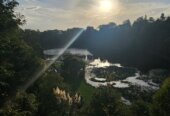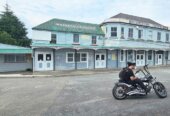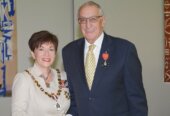
We are the boys: Cambridge’s Home Guard marches down Victoria St – in the 1940s. The shop saying Crystal Toys Fancy Goods is now the Deli on the Corner. If you know the names of any of these men, email [email protected] Picture courtesy Cambridge Museum.
By Luke East
Eight decades ago Cambridge’s very own Home Guard was protecting their patch from Nazi tyranny.
The Cambridge Home Guard was formed in July 1940, following the example of the 1.5 million Brits who had begun forming their own local militias earlier that year.
At the first meeting, held on Fort Street, more than 120 men turned up to enlist and by September the fighting force had nearly doubled. The Company was to be commanded by Captain Edward Kennedy with the four platoons of the Cambridge Home Guard being commanded by Alf Swayne, Arthur Richardson, Willie Webber and Dave Lundon. Subsequently a Roto-o-Rangi platoon was formed and was commanded by Captain David Dillon and later a Karāpiro platoon was also formed, in part to defend the dam from any enemy attacks.
In late 1941 a mock battle was staged at the Cambridge Gasworks (now the Gaslight Theatre) with the platoons led by Swayne and Lundon taking the place of enemy forces and those of Richardson and Webber fighting to subdue them. The tactics and actions of all the platoons were praised by their Commander.
In 1942 members of the Cambridge Home Guard and a number of soldiers who had returned to Cambridge on leave used the Kaimai Range as a training ground and the poem ‘Kaimai Battle’ was duly written, recording their exploits. The poet records how the men set off early with “heavy packs… weighted down with tools and grub” and trekked through “boggy tracks” in the pouring rain before building huts, felling trees to light fires and running training exercises.
As Japanese forces increasingly expanded their presence in the Pacific the existence of Home Guard companies like Cambridge’s became a matter of necessity in case the Axis forces should venture to occupy New Zealand. Many cities had anti-aircraft batteries and the likes of Raglan had laid anti-tank traps to prevent any coastal invasions; in Cambridge members of the Home Guard used treacle, cocoa and other tins to make Molotov Cocktails and other explosives and some members were sent to Narrow Neck Military Camp in Auckland for a fortnight-long course on the laying of anti-tank traps and other methods of guerrilla warfare.
By the time the New Zealand Home Guard was disbanded in December 1943 more than 740 men had served in the Cambridge Home Guard (a sizeable chunk of Cambridge’s population of 5000, given that most able-bodied men would have already gone to serve overseas) and had been instrumental in ensuring New Zealand was defended against any potential invaders.
- If you know the names of any of these men, email [email protected] Picture courtesy Cambridge Museum.








